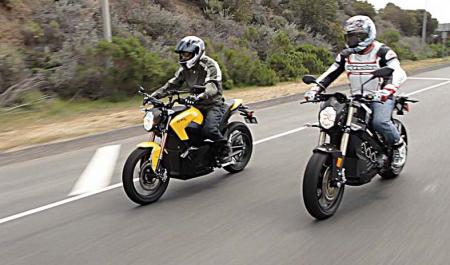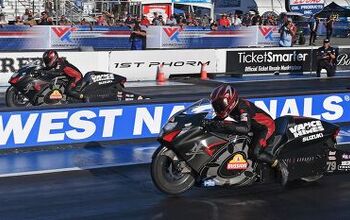2013 Brammo Empulse R Vs Zero S ZF11.4 - Video - Motorcycle.com
E-bike technology has reached new levels of performance that will impress traditional motorcyclists as well as techno geeks. With 100-mph top speeds and purported ranges beyond 100 miles, the recently reviewed 2013 Zero S and Brammo Empulse are the most advanced electric motorcycles in mass production.
Apologies, for now, to Lightning Motorcycles, which has thus far only been in very limited production of its streetbike based on its racing progenitor. At $38K, it resides in a much higher plane than the Zero and Brammo, but its performance is nothing less than awesome. “The Lightning, without a doubt, is the fastest motorcycle I’ve ever ridden – gas or electric,” wrote our Troy Siahaan in his review of the Lightning.
RESEARCH: Read our Electric Motorcycles Primer
Everything you need to know about electric motorcycles you learned while playing with your childhood train set. Turning the dial on the transformer conducts an electrical current to the locomotive’s motor and the train accelerates forward. Twisting the throttles on the Brammo Empulse R and Zero S sends a signal to each bike’s controller which requests a measure of stored energy from the batteries and delivers that amount to the motor. The motor spins the rear wheel via the drivetrain and away you go.
The Sevcon Gen4 controller aboard the Brammo Empulse R and Zero S is more complicated than your train set’s transformer, but the resulting forward thrust from electrical energy remains the same. Delivering the unleashed battery power from the controller to the rear wheel is where these two electric motorcycles diverge from one another.
Unlike an internal combustion engine (ICE) requiring RPMs to produce peak power, an electric motor is capable of delivering all its potential immediately upon request. Such instantaneous ferocity needs moderating, especially from a dead stop unless flipping bikes like pancakes is the goal. To smooth power delivery Zero relies entirely on its controller to dole out battery juice in digestible amounts through its single-speed drivetrain whereas Brammo utilizes a combination of controller and a traditional multi-gear transmission.
The benefit of Zero’s operation is uncomplicated, twist-and-go user-friendliness at the cost of slower off-the-line acceleration and a lesser top speed. The use of only one gear forces Zero to balance the amount of low-end power with top-speed capability – where more of one inversely affects the other. Brammo’s Empulse, like ICE-powered motorcycles, uses a six-speed transmission to match the torque ratio more equally to the speed being travelled. The controller still dictates how much battery power is used, but its influence is lessened and the result is quicker off-the-line acceleration and a higher top speed.
“The Empulse left the Zero for dead in an acceleration contest from a complete stop, as the torque-multiplication benefits from its gearbox makes the Empulse the drag racer’s choice,” says EiC, Kevin Duke. “Yet, to declare the Brammo the clear winner in terms of power isn’t telling the whole story. A roll-on contest at 55 mph (with the Empulse in fourth gear) showed the Zero has a slight edge.”
Yes, even with an 83-pound weight disadvantage and nearly identical claimed horsepower and torque figures the Empulse walked away from the Zero S at stop lights. When in the meat of its power and with only one gear, the Zero S clearly held the upper hand (largely due to its lesser weight) during roll-on races, but the acceleration advantage of having a transmission is unequivocal.
Detrimental to its cause, however, is the increased complexity (and weight) of having a gearbox as well as the skills for operating the clutch and shifter. After now having twice tested the Brammo Empulse R we are convinced that six gears is, at least, three gears too many. It’s our opinion either a Low/High or Low/Mid/High transmission will more than suffice. Brammo says the off-the-shelf transmission (with neutral between 2nd and 3rd gears) currently used will eventually be replaced with one developed specifically for use in an electric motorcycle. It’s likely that Polaris Industries’ recent investment in Brammo will result in a co-developed gearbox at some point in the future.
Beyond the Gearbox
The functionality of these two disparate drivetrains is representative of each bike’s general approach to electric motorcycling. Where the Empulse is clearly designed to attract a traditional motorcycle enthusiast, Zero’s approach is toward a much broader crowd including non-motorcyclists as well as motorcyclists.
While seat heights differ by just 0.2 inch, the lighter weight of the Zero S ZF11.4 is less intimidating. Add to that a comfortable seating position with low-placed footpegs, a convenient storage compartment (where the fuel tank would normally reside) and a maintenance-free belt final-drive for a price $3k less than the Empulse R ($1k less than a standard Empulse) and the attraction is obvious.
“I loved having the Zero in the garage,” said Duke after his initial review of the 2013 Zero S. “Nearly 100 pounds less weight, the Zero is by far the easier commuter bike, and although its storage compartment isn’t very secure, it proved to be incredibly handy.”
Taking these bikes out to the canyons provided Brammo the opportunity to showcase how much like an ICE-powered sportbike an electric production motorcycle can be. With power enough to break the 180/55 rear tire loose exiting corners, monster stopping performance from its dual, radial-mount Brembo calipers, and exceptional cornering clearance the Empulse R will put a lot of conventional sportbikes in its rearview mirrors given the opportunity.
COMPARISON: Read our 2010 Electric Motorcycle Shootout
The Empulse R’s one stark fault is unwelcome driveline lash. “My biggest gripe about the Empulse is the way it delivers its power,” says Duke. “It exhibits jerky response when trying to accelerate gracefully from a stop, and its excessive driveline lash makes it a challenge to ride smoothly. A clunky transmission with an overabundance of gears complicates matters compared to the simple, efficient and smooth Zero. A considerable delicacy is needed with the throttle when entering corners on the Brammo, as it needs to be cracked slightly open to avoid the extra speed retardation from regenerative braking that can upset the bike’s balance.”
The nimble Zero S used its lesser weight, shorter wheelbase and narrower tire width to its advantage, but the limited cornering clearance of its low-placed footpegs kept it from ever seriously challenging the hard-charging Empulse R.
| Range in Miles | ||||
| City (Claimed) | Freeway (Claimed) | Combined (Claimed) | As Tested (Under the worst conditions) | |
| Brammo Empulse R | 121 | 56 | 77 | 50 |
| Zero S ZF11.4 | 137 | 70 | 93 | 63 |
However, it’s the taking these bikes out to the canyons where the problem exists. With severely limited range it’s not often you’ll be riding either of these electric motorcycles far from urban centers. And until the range significantly improves, or quick-charging stations proliferate outside city limits, the Brammo has few opportunities to showcase its talents.
Charge
Like their drivetrains, Brammo and Zero are both consigned to differing philosophies when it comes to charging their products. Both the Zero S and Empulse R are endowed with standard automotive chargers that can be plugged into the common 110V (Level I) outlet around your home or garage.
For Zero it’s a simple matter of removing the extension cord from its in-frame storage compartment and plugging it into the bike’s charger and the Level I wall outlet. Brammo, however, requires a Level I adaptor because its on-bike outlet is of the J1772 variety.
J1772 is the official electrical connector standardized by the Society of Automotive Engineers (SAE). According to the various Level II charging maps and apps, such as PlugShare.com, there are numerous charging stations available nationwide where J1772 equipped vehicles can quickly recharge their batteries.
| Charging | ||
| Level 1 | Level II | |
| Brammo Empulse R | 7.9 hours 0-100% 7.4 hours 0-95% J1772-to-Level I outlet adaptor needed (included with purchase of bike) | J1772 3.5 Hours 0-99% ChargePoint card included with purchase of Empulse R |
| Zero S ZF11.4 | 8 Hours 0-100% Optional quick-chargers 1 Charger - $750 4 Hours 0-100% 2 Chargers - $1,500 2 Hours 0-100% 3 Chargers - $2,250 1 Hour 0-100% | CHAdeMO 1 Hour 0-95% Must purchase CHAdeMO socket kit - $1,800 |
Zero has chosen to align itself with the alternative CHAdeMO system which is the choice among Japanese electric vehicle manufacturers with nearly 1,700 quick-charging stations in Japan but only 160 stations stateside. It’s been reported that thousands more CHAdeMO stations will be constructed in the U.S. by 2014, but for now they remain limited to a few hot spots in states such as Oregon, Texas, Tennessee and Illinois.
Both the Brammo Empulse R and Zero S ZF11.4 demand an eight-hour period to charge their batteries from 0 to 100% using a Level I outlet. But whereas the Empulse R’s J1772 quick-charge station can recharge its batteries to 95% in 3.5 hours, Zero’s CHAdeMO quick-charger can recharge its batteries to 95% in as little as one hour. To take advantage of any nearby CHAdeMO stations however, you’ll need to purchase a CHAdeMO socket kit, which adds $1,800 to the purchase price of the Zero S, bringing the S to within $1200 the Empulse R’s MSRP.
J1772 vs CHAdeMOThe reason why CHAdeMO is able to so quickly recharge the Zero’s battery is because the device internally converts AC current from the grid to DC current. The CHAdeMO charger then bypasses the bike’s on-board charger, delivering the DC current directly to the Zero’s batteries. J1772 delivers AC current directly to Brammo’s on-board charger which must first convert the AC current to DC current, then deliver the charge to the batteries.
The Brammo’s on-board 3 kW charger is able to take advantage of J1772 outlets whereas Zero’s 1.3 kW on-board charger using a J1772 outlet will charge at the same rate it does with a Level I outlet. Zero does offer a J1772 charging adaptor for $400. It’s been reported that future J1772 stations will be modified to provide DC-direct charging, while other reports say charging stations may soon provide both types of outlets until the best coupling can be determined.
Zero also offers a scalable Level I quick-charge system ($750), that reduces level I charge time from eight hours to four. The system is scalable where two more Level I quick-chargers can be added (three total) further halving charge time from four to two hours and finally to one hour.
Other Considerations
The Zero’s instrument cluster is spartan and doesn’t provide as much information as the Brammo’s, but Zero does offer an app that’s customizable for torque, top speed and regenerative braking as well as on-screen information. Zero offers a smartphone handlebar mount for easy viewing of the additional information or convenient GPS map navigation. Brammo claims to have a superior app in the works, but nothing currently available.
| Brammo Empulse R Highs: | Brammo Empulse R Sighs: | |
| Has a transmission Awesome brakes J1772 quick-charging is prevalent | Too many gears in the transmission Chain final-drive Heavy curb weight |
While both manufacturers utilize the latest lithium-ion batteries, where Zero relies on air-cooling to manage battery temperature, Brammo cools its batteries via fans as well as heats its batteries when temperatures dip below optimal Fahrenheit levels. Brammo also utilizes liquid-cooling to maintain the optimal temperature of its controller.
| Zero S Highs: | Zero S Lows: | |
| Convenient storage compartment Easy for the inexperienced to operate There’s an app for that | Footpegs too low Still reminiscently mountainbike-like CHAdeMO infrastructure is minimal |
The Empulse R also piles on components including Marchesini wheels, Brembo brakes, Marzocchi fork and Sachs shock – recognizable names to motorcyclists.
“The power and feedback from the Brammo brakes are excellent and beyond reproach, especially for a vehicle that will rarely go faster than 80 mph,” says Duke. “But while the Nissin brakes on the Zero aren’t standouts like the Empulse’s, I find them quite well suited to the bike. They deliver decent feedback and a firm lever through steel-braided lines. One beef: the rear brake pedal is mounted too high for an easy reach.”
Both bikes, however, are in dire need of a parking brake. Parking either bike on a slope has the potential to end in tears.
When discussing e-bikes, traditional motorcyclists often complain about the lack of visceral and ear-appealing engine noise. While the Brammo and Zero are certainly much quieter than any ICE-powered motorcycle, they’re certainly not silent, as you can hear in the accompanying video.
“The Empulse has gotta be at least three times louder than the Zero,” Duke notes, attributing its extra noise to the whining of its transmission gears and chain drive the Zero doesn’t have. “It sounds like an angry giant food processor.”
From its transmissionless, twist-and-go operation, to its low weight, comfortable footpeg placement and handy storage compartment (where the fuel tank should reside) the Zero S is meant to be all things to all people. On the other hand, the Empulse R’s sporty seating position, gearbox, monster brakes, excellent cornering clearance, 180/55 rear tire all conspire to make to Empulse as motorcycle-like as possible.
FUTURE: The State of Zero in 2012 and Beyond
“Of this pair, the Empulse most closely resembles and feels like a real motorcycle,” says Duke. “The Brammo’s handling reminds me of a slightly porky SV650, which I believe is an authentic compliment.”
One way in which Brammo may have gone too far in its similarity to ICE-powered bikes is having a starter button that must be depressed after having already turned the ignition key. Brammo says the function is a safety feature to keep people from inadvertently twisting the throttle on a machine that emits no visual or audio indication that it's “running.” We found the extra process redundant and the wait time annoying.
“After turning its key and waiting for the instruments to go through its diagnostic check, a rider still has to push a “starter” button that is purely superfluous, as there is no engine to “start,” Duke whines. “I just want to jump on it and go.”
While the Brammo is the bike we’d most like to ride at a track, the Zero, and its broader appeal, has the edge when it comes to everyday usability.
But considering the rate at which both Brammo and Zero are developing electric motorcycle technologies, this equation is sure to get shuffled before too long. Stay tuned.
| By the Numbers | ||
| Brammo Empulse R | Zero S ZF11.4 | |
| MSRP | $18,995 | $15,995 |
| Horsepower | 54 @ 4500 rpm | 54 @ 4300 rpm |
| Torque | 66 ft-lb | 68 ft-lb |
| Battery Type | Lithium-ion | Lithium-ion |
| Nominal Battery Capacity | 9.3 kWh | 10.0 kWh |
| Motor Type | Liquid-cooled, permanent magnet brushless | Air-cooled, permanent magnet, brushless |
| Motor Controller | Sevcon Gen4 | Sevcon Gen4 |
| Transmission | 6-speed gearbox | Single-speed, direct drive |
| Clutch | Multi-plate, hydraulic wet clutch | NA |
| Final Drive | Chain | Belt |
| Frame | Brammo Aluminum E-Beam | Aluminum twin-spar |
| Front Suspension | Inverted, fully Adjustable 43mm Marzocchi Fork | Inverted, 38mm fork with adjustable compression and rebound damping |
| Rear Suspension | Fully adjustable Sachs shock | Fully adjustable piggy-back reservoir shock |
| Front Tire | 120/70-17 | 110/70-17 |
| Rear Tire | 180/55-17 | 130/70-17 |
| Front Brakes | Dual radial-mount 4-piston Brembo calipers, 310mm discs | Dual Nissin two-piston calipers, 313mm floating disc |
| Rear Brakes | Brembo 2-piston caliper and disc | Nissin 1-piston caliper, 221mm disc |
| Rake/Trail | 24° / 3.8" | 23.8° / 3.2" |
| Wheelbase | 58.0 in. | 55.4 in. |
| Seat Height | 31.5 in. | 31.3 in. |
| Curb Weight | 470 lbs | 387 lbs |
| Colors | True Blood Red, Eclipsed Black, White Noise | Black, Yellow |
| Warranty | 24 months | 24 months |
* Until January 1, 2014, each bike is eligible for a 10% federal tax credit as well as individual state credits.
Related Reading
2013 Zero S Review
2013 Brammo Empulse R Review - Video
2012 Lightning Motorcycles Exclusive First Ride - Video
Recharging TTXGP
More by Tom Roderick





































Comments
Join the conversation